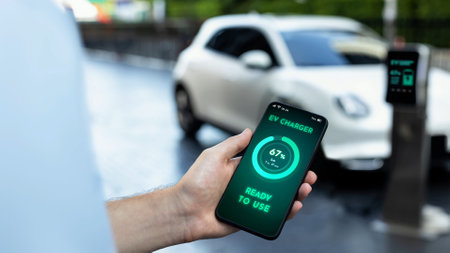1. Introduction: A Tale of Two Settings
The United Kingdom stands at a crossroads, with electric vehicles (EVs) rapidly transforming the landscape of how Britons travel, live, and connect. From the bustling streets of London to the leafy avenues of Surrey, the surge in EV adoption is more than just a technological shift—it’s a cultural evolution. Yet, as more drivers plug in rather than fill up, clear lines are being drawn between urban vibrancy and suburban calm. City centres pulse with energy, their dense infrastructure pushing the frontiers of public charging innovation. Meanwhile, suburban neighbourhoods offer space and tranquillity but face their own unique challenges when it comes to charging availability and convenience. As Britain journeys towards a greener future, understanding these contrasting environments is key to navigating the practical realities—and hidden costs—of going electric. This tale of two settings sets the stage for a deeper exploration into how location shapes our EV experiences, from access and affordability to the daily rhythms of British life.
2. The Landscape of EV Charging Points
When traversing the electric vehicle (EV) charging landscape in Britain, one cannot help but notice the stark contrast between the urban hustle and the suburban sprawl. In cities such as London, Manchester, or Birmingham, the tapestry of public charging points is woven tightly into the fabric of daily life. Urban density ensures that chargers are more prevalent—peppered across high streets, multistorey car parks, and even nestled discreetly beside historic landmarks. For city dwellers, convenience is paramount; proximity to reliable infrastructure means a quick top-up is never far away.
Meanwhile, the British suburbs and countryside paint a different picture altogether. Here, residential driveways and garden spaces often allow for home charging—a luxury less common in the terraced townhouses and flats of urban centres. Public charging points, by contrast, are more sparsely scattered across suburban retail parks or rural service stations, reflecting both lower population density and greater reliance on private vehicles.
Distribution of Charging Infrastructure: Urban vs. Suburban
| Urban Areas | Suburban & Rural Areas | |
|---|---|---|
| Charging Point Density | High (multiple per square mile) | Low (few per village/town) |
| Typical Locations | Car parks, shopping centres, on-street | Supermarkets, service stations, leisure centres |
| Access Methods | App-based access, contactless payment | Mainly app-based; some require membership |
Navigating Availability and Access
The British government has invested heavily in expanding urban charging networks to keep pace with rising EV adoption. Yet, this progress brings its own challenges: higher demand in city centres can sometimes lead to queues or competition for charging bays during peak hours. Conversely, while suburban drivers may enjoy greater ease at home, those relying on public chargers might need to plan their journeys with more care—especially when venturing into the countryside where infrastructure is still catching up.
The Heartbeat of Mobility: A Cultural Perspective
The distribution of EV charging points across Britains urban and suburban landscapes mirrors not just geography but also cultural rhythms—the buzz of city life versus the measured pace of rural living. This dynamic interplay shapes how Britons experience electric mobility: whether it’s a quick pitstop after a West End show or a leisurely charge before a ramble through the Cotswolds.

3. Availability and Accessibility: The Urban Edge or Suburban Stretch?
When it comes to finding a charge for your electric vehicle, the landscape across Britain is as varied as its historic towns and sprawling suburbs. In the heart of the city, drivers often enjoy the ‘urban edge’: densely packed charging stations peppered along high streets, shopping centres, and public car parks. Londoners, for example, benefit from an ever-growing network of rapid chargers conveniently positioned near places of work, leisure, and culture—a reflection of both demand and the city’s commitment to cleaner air. However, this abundance is tempered by fierce competition for charging bays and the infamous scarcity of off-street parking. For many urban dwellers in Victorian terraces or Edwardian maisonettes, plugging in at home remains a luxury rather than a given.
In contrast, the suburban experience—the so-called ‘suburban stretch’—offers a different kind of convenience. Here, driveways and garages are commonplace, giving residents the privilege of installing home chargers and waking each morning to a fully charged battery. This private access brings peace of mind but can also mean fewer public charging points per square mile compared to city centres. Suburban drivers may need to plan longer journeys with greater care, particularly if venturing beyond commuter belts into rural areas where public infrastructure thins out.
British nuances further shape this landscape. Narrow streets in older urban neighbourhoods challenge local councils to retrofit charging infrastructure without disrupting heritage charm or pedestrian life. Meanwhile, suburban councils weigh up investment in public chargers against the prevalence of off-street parking. The quintessential British terrace—with its lack of front gardens—faces unique barriers to easy EV adoption that simply don’t exist for their semi-detached or detached suburban counterparts. Ultimately, whether you’re navigating cobbled city lanes or leafy suburban crescents, the ease of EV charging hinges on both geography and a patchwork of local initiatives reflective of Britain’s rich diversity.
4. Cost Considerations: From High Street to Home
When it comes to the cost of charging an electric vehicle in the UK, the landscape is as diverse as the British countryside itself. Urban drivers, often reliant on public charging points scattered across bustling high streets and retail parks, face a different pricing reality compared to their suburban counterparts who may have access to home charging. In cities such as London or Manchester, rapid chargers are conveniently located but tend to command a premium rate, particularly during peak hours when demand surges. Meanwhile, suburban EV owners are more likely to install home chargers, taking advantage of lower off-peak electricity tariffs and clever smart-meter scheduling—turning the humble garage into a cost-saving sanctuary.
Comparing Typical Charging Costs
| Charging Location | Urban Average (£/kWh) | Suburban Average (£/kWh) |
|---|---|---|
| Public Rapid Charger (Peak) | £0.65 | £0.60 |
| Public Rapid Charger (Off-Peak) | £0.55 | £0.50 |
| Home Charging (Standard Tariff) | N/A | £0.30 |
| Home Charging (Off-Peak/Special Tariff) | N/A | £0.17 |
This table illustrates that those with access to home charging in suburban areas enjoy significantly reduced costs, especially when leveraging special tariffs such as Economy 7 or Octopus Go. Urban dwellers without private driveways often pay nearly double per kilowatt-hour at public stations—a price for city convenience.
The Art of British Budgeting
The savvy British motorist is no stranger to budgeting and has quickly adapted to the new economics of EV ownership. Many urbanites employ loyalty schemes or subscription models offered by major charging networks to soften the blow of higher street-side prices. Meanwhile, suburban families plan their charging around off-peak windows, making use of timer functions and smart meters—demonstrating that with a bit of foresight and local knowledge, the cost gap between town and country can be skilfully bridged.
5. Convenience Factors: Time, Location, and Everyday Life
When considering the practicality of EV charging, convenience becomes a defining factor, deeply woven into the fabric of daily British life. The rhythms of urban and suburban existence dictate not only where but also how and when drivers top up their batteries. In bustling city centres, time is often in short supply. Commuters dart between work and home, navigating crowded streets and tight schedules. Urbanites may favour rapid charging points strategically placed near offices, train stations, or shopping arcades—allowing them to integrate charging with their daily dash for a morning coffee or an impromptu supermarket stop. Here, the convenience is found in proximity and speed: a quick charge before a meeting or while grabbing lunch.
Contrast this with the suburban lifestyle, where space is more plentiful and routines revolve around family commitments. Home charging reigns supreme in leafy neighbourhoods, enabling residents to plug in overnight and set off each morning fully charged—a ritual as British as the first cup of tea at dawn. For many families, the school run shapes the day’s schedule. Suburban parents often plan their EV usage around these twice-daily journeys, appreciating the ease of returning home to a personal charger after dropping off little ones at the gates of local primaries.
The legendary British school run—an institution in itself—illustrates how charging habits adapt to everyday patterns. Whether its squeezing in a top-up during after-school activities or timing weekend trips to coincide with a visit to a retail park charger, flexibility is key. Suburbanites value predictability: knowing that their vehicle will be ready for the next round trip without detours or delays.
Ultimately, convenience in EV charging is shaped by lifestyle nuances unique to each setting. Urban dwellers prioritise quick access and minimal disruption; suburbanites lean into routine and reliability. Both approaches reflect a distinctly British blend of tradition and innovation—adapting new technology seamlessly into the established rituals that underpin daily life.
6. Challenges and Innovations: Bridging the Urban-Suburban Divide
The journey towards a truly electrified Britain is not without its hurdles. Urban and suburban areas each face unique challenges in the race to provide seamless EV charging experiences, but it is precisely this diversity that has sparked a wave of British ingenuity. In our cities, limited space and high demand have pushed local councils to get creative, transforming lamp posts into discreet charging points and rolling out rapid charging hubs in car parks and shopping precincts. Meanwhile, suburban communities grapple with longer travel distances and fewer public chargers per capita, yet they benefit from driveways and garages perfect for home charging setups.
Recognising these disparities, councils across the UK are stepping up with tailored solutions. Programmes such as the On-Street Residential Chargepoint Scheme (ORCS) are channelling funding into neighbourhoods previously overlooked by private providers. In places like Greater Manchester and the Home Counties, partnerships with tech startups are piloting community charging networks, where residents share their home chargers with neighbours via user-friendly apps.
Britain’s commitment to a greener future extends beyond infrastructure alone. The government’s ambition for a zero-emission transport system is mirrored in grassroots action—local authorities hosting EV awareness days, retailers offering free charging as a customer perk, and forward-thinking housing developers integrating chargepoints into new builds as standard. This national movement is not just about cables and kilowatts; it is about knitting together a patchwork of innovation that bridges the gap between city buzz and village calm.
The result? A landscape where no postcode is left behind, where the hum of electric engines becomes as familiar in leafy cul-de-sacs as on London’s bustling streets. While challenges remain—be it grid capacity in rural shires or equitable access in deprived boroughs—the spirit of collaboration is unmistakably British. By harnessing both tradition and technology, the UK is setting an example for urban and suburban harmony on the road to net zero.
7. Conclusion: Charging Ahead in Modern Britain
As we reflect upon the nation’s journey towards sustainable mobility, it is clear that the story of EV charging in Britain is one of adaptation, ambition, and community spirit. The contrast between urban and suburban charging landscapes mirrors the diversity woven through British society itself—from the bustling high streets of London to the leafy lanes of Surrey. In cities, rapid innovation has brought about a dense network of public chargers, often situated beside historic pubs or beneath Victorian terraces, supporting those for whom driveways are a luxury. Meanwhile, suburban communities enjoy home-charging convenience and the camaraderie of neighbourhood initiatives, yet must also contend with evolving public infrastructure to meet growing demand.
This evolution is not merely technological but deeply cultural. The shift to electric vehicles represents more than just a change in how we power our cars; it signifies Britain’s collective commitment to cleaner air, quieter streets, and a more sustainable future. As councils, businesses, and households invest in new solutions—whether kerbside chargers or community car clubs—the very fabric of British life is being rewoven with threads of innovation and tradition alike.
The road ahead will require continued collaboration across sectors and regions. Urban planners must balance space constraints with accessibility; suburban developers ought to prioritise inclusive design. Policymakers face the challenge of ensuring fair access and affordable tariffs for all Britons, regardless of postcode. Yet if history has taught us anything, it is that Britain thrives when faced with bold challenges—rising to reinvent itself while honouring its roots.
In this dynamic landscape, the electric vehicle charger has become more than a plug-in point; it is an emblem of progress and possibility. By embracing both urban ingenuity and suburban resilience, modern Britain charges ahead—not simply adapting to change but leading it with characteristic resolve and vision.


